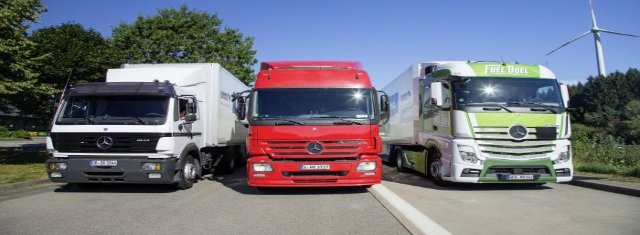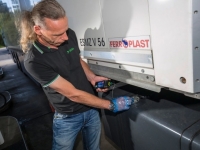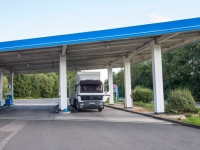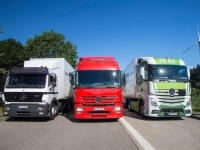Automobiles
Considerable improvements in actual fuel consumption
DEKRA-certified

Independent truck test (Source: © 2016 Daimler AG. All rights reserved.)
USPA NEWS -
DEKRA-certified test drive: Independent truck test shows 22 percent lower diesel consumption and CO2 emissions in 20 years. Considerable improvements in actual fuel consumption from 40.8 l in 1996 to 31.9 l per 100 km in 2016.
Comparative test drive for the fuel consumption of the Mercedes-Benz SK and Actros from three emission standard generations
Absolute comparability assured by identical parameters and independent test institute. Considerable improvements in actual fuel consumption from 40.8 l in 1996 to 31.9 l per 100 km in 2016. This fall in consumption from 1996 to the present day has resulted in a reduction of at least 50 million tons in the CO2 emitted by Mercedes-Benz trucks in Europe. Accompanied by drastic reductions (up to 96 percent) in exhaust emissions from Euro II in 1996 to the currently mandatory Euro VI standard.
Absolute comparability assured by identical parameters and independent test institute. Considerable improvements in actual fuel consumption from 40.8 l in 1996 to 31.9 l per 100 km in 2016. This fall in consumption from 1996 to the present day has resulted in a reduction of at least 50 million tons in the CO2 emitted by Mercedes-Benz trucks in Europe. Accompanied by drastic reductions (up to 96 percent) in exhaust emissions from Euro II in 1996 to the currently mandatory Euro VI standard.
Despite drastically more stringent emission standards for nitrogen oxides and particulates, the fuel consumption of heavy trucks has been reduced by 22 percent over the last 20 years. This has now been proved by a comparative test drive certified by the test organisation DEKRA. In August 2016, three Mercedes-Benz trucks from 1996, 2003 and 2016 were put through their paces on the demanding and universally recognised test circuit of the commercial vehicle magazine "Lastauto Omnibus".
What had been developed by Mercedes-Benz with major financial and technical investment over a long period of time proved to be successful on the road. Over the last two decades, successive in-house test drives on e.g. the long-distance Stuttgart-Hamburg-Stuttgart route repeatedly showed reductions in fuel consumption. This was also proved during the independent and exhaustive test drives conducted by DEKRA and "Lastauto Omnibus".
The result is a certified fuel economy advantage of 22 percent for the latest generation of the Mercedes-Benz Actros long-distance truck compared to the basic model of 1996, a Mercedes-Benz from the SK model series and therefore one of the last representatives of the pre-Actros era. The model 1844 was certified according to the Euro II standard valid in 1996, and was therefore allowed to emit seven grams of NOx per kilowatt hour (kWh) while staying within the limiting value of 0.15 g/kWh for particulate matter. The number and size of the soot and other particles was not prescribed.
The second test vehicle, an Actros 1846 (production year 2003) was certified according to emission standard Euro III, with five grams of NOx per kilowatt hour (kWh) and 0.10 g/kWh of particulate mass. The latest-generation Euro VI Mercedes-Benz Actros 1845 was the third test vehicle. For comparison: A current Euro VI Actros betters the old Euro II limits by 94.3 percent (NOx, present limit 0.4 g/kWh) and 96 percent (0.01 g/kWh) for particulate mass, though today's measuring conditions are far more stringent.
This reduction in fuel consumption has resulted in savings of more than 50 million tons of CO2 by Mercedes-Benz trucks in Europe since 1996. This calculation is based on the following parameters: sales of around one million Mercedes-Benz trucks in the segment of long-distance transport in Europe between 1996 and today, as well as a conservative estimate for the annual mileage of 75 000 km per vehicle, and a service life of eight years. The current fuel consumption per 100 km measured during the certified DEKRA test run for the years 1996, 2003 and 2016 is extrapolated on a linear basis for the other years.
Against a background of drastically reduced emission levels in the "traditional" pollutant categories, the actual on-the-road consumption for the test covering 1536 kilometres on very demanding topography with a test weight of 40 tons showed the following results: While the 20 year-old Mercedes-Benz SK (model 1844) reached a figure of 40.8 l per 100 km, the Actros 1846 Euro III consumed 37.4 l per 100 km and the current Euro VI Mercedes-Benz Actros 1845 only 31.9 l/100 km ““ over an identical route and distance.
The magazine "Lastauto Omnibus" has long been known for conducting such comparative test drives according to strict rules. In addition, Dekra took part in this three-generations comparison as an independent test organisation. This test verification was particularly appropriate because the positive development in the fuel consumption of heavy trucks is currently under constant scrutiny by politicians.
The test was structured according to the principles which "LaO" test manager Frank Zeitzen has defined for all on-road fuel consumption and vehicle mileage measurements. These include test vehicles that have been identically prepared as far as possible, and highly experienced truck test journalists at the wheel. The test drivers took turns behind the wheel after each test round, and the semitrailers were changed every day.
This ensured that the trailers being towed were used the same number of times with each tractor unit. This eliminates differences in e.g. rolling characteristics. The semitrailers were identically loaded and had the same tyres. For this three-generations comparison, three box semitrailers were loaded to an identical 32 tons and fitted with the same tyres. So as to reflect progress made in rolling characteristics as well, the basic Mercedes-Benz SK 1844 truck from 1996 was shod with the then very popular Michelin XZA/XDA tyres in size 295/80-22.5.
The second test truck, the Actros 1846 (from 2003) was fitted with tyres from the Michelin Multiway family, in size 315/70-22.5 still current today. The latest-generation Actros 1845 Euro VI was fitted with factory-fresh Michelin tyres in size 315/70-22.5. Where the mileage of the test vehicles is concerned, the new Actros Euro VI was at a slight disadvantage. With just over 8000 km on the clock, it was not yet quite run-in. The best fuel economy thanks to minimised resistances within major assemblies is normally to be expected after around 50 000 km.
The 20 year-old basic vehicle, the Euro II Mercedes-Benz SK 1844 dating from 1996, had an odometer reading of 610 000 km.
"LaO" test manager Zeitzen prescribed the same driving style with exact requirements for himself and the other two test drivers, Michael Kern and Vassilis Daramouskas. The cruising speed and overshoot/undershoot times for downhill and uphill gradients were defined and monitored by the recording personnel. Conventional cruise control was used to ensure a consistent cruising speed for the two older trucks. In the latest Actros this was taken care of by the Predictive Powertrain Control (PPC) system.
"LaO" test manager Zeitzen prescribed the same driving style with exact requirements for himself and the other two test drivers, Michael Kern and Vassilis Daramouskas. The cruising speed and overshoot/undershoot times for downhill and uphill gradients were defined and monitored by the recording personnel. Conventional cruise control was used to ensure a consistent cruising speed for the two older trucks. In the latest Actros this was taken care of by the Predictive Powertrain Control (PPC) system.
All in all, six measuring rounds of 256 km were absolved on the Lastauto Omnibus test circuit. The test drivers changed vehicles after each measuring run, and the 32-tonne trailers were also exchanged in accordance with the assigned driver. Every evening the vehicles were refuelled under precise, temperature-compensated conditions. With this highly precise test preparation and execution, the results obtained from this real road test are of very high practical relevance. The fuel consumption levels in such a three-generations comparison will however be different on other test routes.
No great differences are to be expected in the relative figures, but the absolute figures will differ ““ the current Lastauto Omnibus test circuit is regarded as comparatively demanding. More demanding than the previous two-day tour from Stuttgart to the Werra Valley in Hessia and back. And more demanding than e.g. the classic Stuttgart-Hamburg-Stuttgart test route used by Mercedes-Benz to measure trip consumption.
To ensure even better comparability of actual fuel consumption by trucks in future, Europe's truck industry has agreed to develop a measuring cycle. The test procedure intended to achieve this breakthrough is called "Vecto". Vecto stands for "Vehicle Energy Consumption Calculation Tool". Here too, the major input data are measured and subsequently processed using a calculation tool officially provided by the European Commission.
The test course to be used has been defined as representative of European long-distance operations in a very involved process. For example, the aerodynamic drag of every single cab variant of a truck model has been measured on the road by independent test organisations. The same applies to the rolling resistance of tyres. Here too, the tyre manufacturers have had to demonstrate the rolling characteristics of their product lines, i.e. different sizes, substructures and tread patterns, in extensive road tests.
Where the powertrain consisting of the engine, transmission and drive axle(s) is concerned, as in the case of the cab, it is the vehicle manufacturer who must deliver. The Vecto test procedure is currently being finalised in the official committees of the European Union, and will first be used for the most important truck segments (long-distance and distribution) in the summer/autumn of 2018.
more information: https://www.dekra.com/en/home
Liability for this article lies with the author, who also holds the copyright. Editorial content from USPA may be quoted on other websites as long as the quote comprises no more than 5% of the entire text, is marked as such and the source is named (via hyperlink).








